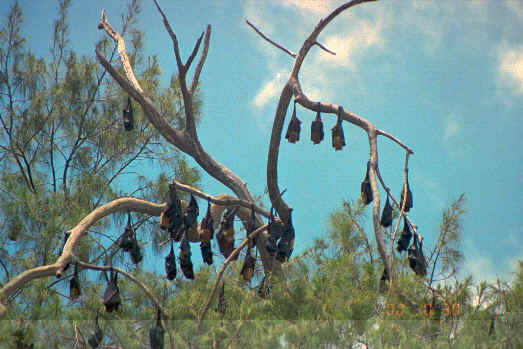| S/V
Tethys |
Mount Talau National
Park |
| We got a small brochure from the
Tourist Bureau in Neiafu that describes the highlights of Mount Talau park and guides one
over the rudimentary trails. The brochure was published with funds from the Canada Fund.
The one sign at the start of the trails was probably paid by the same fund except some wag
broke of the end of the sign and it now reads Canada Fun! There is a short staircase, all
of about 10 steps leading up to the escarpment and then a thick rope strung up between the
trees to help climb up the path to the plateau. The local joke is that the Canada Fund ran
out of money and the Tongans provided their own solution. |
| The flora of Mt. Talau includes many culturally significant plants and several
species of trees that are considered rare and endangered in Tonga. Most birds (17 land species) and reptiles can be
found on Mt. Talau. We did not spot the Fokai (Banded Iguana), an
extremely rare and beautiful reptile which is described as having blue and green colouring
and delicate features. As they are about one metre in length I think we would have noticed
one if it had made an appearance. There are also three types of gecko and four types of
skinks, all of which are known as Moko in the Tongan language. We saw
lots of small lizards and it is a good thing they are all called the same as it is
difficult to identify the quick scurrying creatures anyway. The only exception is the
blue-tailed skink, which is about three inches long and really does have a turquoise tail. |
| From a lookout high above the causeway over
Vaipuua Bay, we spotted what we thought were frigate birds flying along the edge of the
hillside over the water. Then we realized that these were actually Tongan Flying Foxes
(which are really bats, and locally called Peka). This large fruit eating
bat, is the only mammal native to Tonga. We were surprised to see them because we thought
they were mainly nocturnal, and we had expected to see them roosting in the trees, hanging
upside down. We were even more delighted when, at another overlook, several of the bats
flew by quite close, giving us a good look at their three foot wingspan and the yellow fur
on their heads. The Peka is important in maintaining the health of Tongan
forests by dispersing the seeds of forest trees in their poop and they also act as
pollinators by feeding on the nectar of flowers. Populations of fruit bats in neighbouring
islands like Fiji have fallen sharply in recent years due to hunting but in Tonga the Peka
is considered sacred and only the members of the royal family are allowed to hunt them. As
a result of this cultural taboo, the population of flying foxes in Tonga has remained
stable. |
 |
| As Canadians we were happy and proud to see that this
park was developed with the help of the Canada Fund. Information about the wildlife on
this page is taken from the Mount Talau National Park brochure. |
| On the way down to the village we passed by the King's
Vava'u residence but he was not there and the gates were locked. It is not a large house,
but looks well kept with a red roof and white walls. Sort of an extended bungalow. He has
a nice view of the Neiafu Harbour. |

